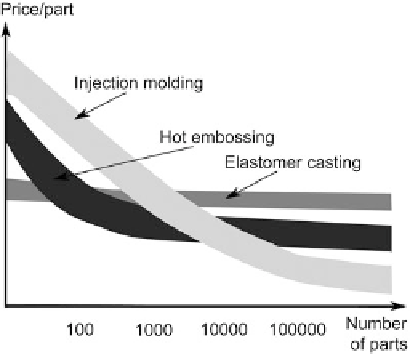Biomedical Engineering Reference
In-Depth Information
Fig. 7.27
Qualitative
economy-of-scale
comparison for polymer
replication processes,
including injection molding,
hot embossing, and PDMS
casting (Reproduced from
Ref. [
112
] with permission
of The Royal Society
of Chemistry)
pushed other devices to also combine with the LFT strip for readout [
119
]. Recent
reports gave many solutions for LFT-based DNA analysis. Wilson and coworkers
proved that the PCR products can be sandwiched between reporter oligonucleotides
covalently attached to gold nanoparticles and capture oligonucleotides covalently
attached to a nitrocellulose membrane [
120
], just like the principle of sandwich
ELISA (enzyme-linked immunosorbent assay). If the reporter probes were fur-
ther adsorbed with HRP (horseradish peroxidase), the visualization effect can be
enhanced through an HRP-catalyzed AEC (3-amino-9-ethylcarbazole) colorimetric
reaction that produces an insoluble colored product [
121
,
122
]. Other amplified
products obtained by isothermal techniques, such as LAMP, were also combined
with the LFT, resulting in a visual detection [
123
]. It is far less clear whether the LFT
is a right direction for DNA analysis, because simpler readout (such as LAMP result
can be readout by a portable ultraviolet lamp) has been achieved without the use of
strips, and the strips cannot carry out the amplification reactions on itself. Separate
amplification in tubes or other chips is always required. In addition, researchers
should firstly clear the aim, for a qualitative or for a quantitative analysis. For
the later, the visual detection will be not sufficient because of differential vision
problems in individuals. Electronic devices could solve this issue. Glucometer,
another successful commercial product aiming to POCT, is an outstanding example,
because it could display a value on the device and tell the quantity of the target to the
end user [
124
]. However, almost all current feasible approaches adopted separate
rather than integrated electronic readers for signal readout in quantitative DNA
analysis [
125
-
128
], because of the incompatibility between the widespread PDMS-
based microfluidics and well-established MEMS (microelectromechanical system)
technology [
117
]. We should take the whole dimensions and whole costs including
the chip and others off the chip into account. Meanwhile, the fast development of
technologies may completely overcome the incompatibility issue in the near future
[
129
-
132
].

Search WWH ::

Custom Search